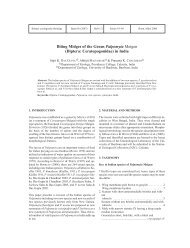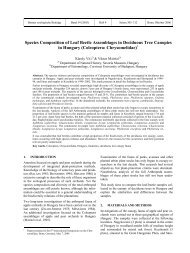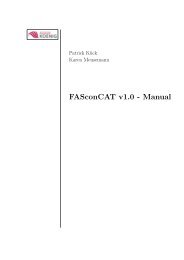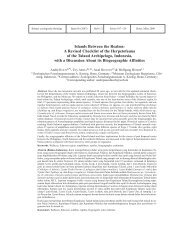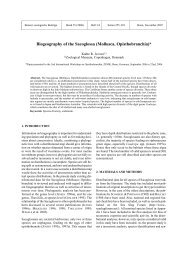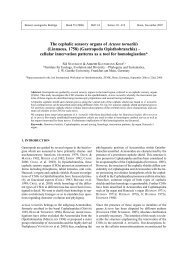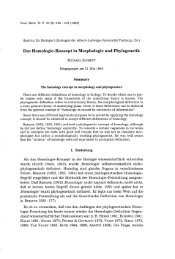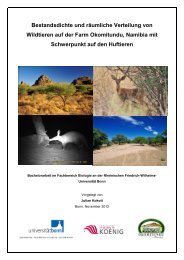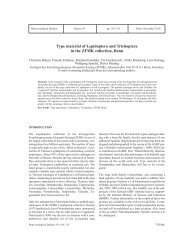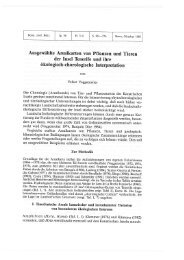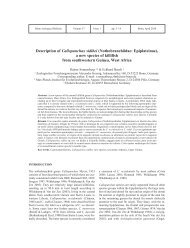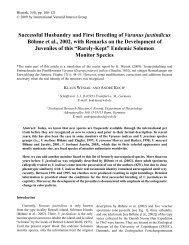New records of snakes from Cat Tien National Park, Dong Nai and ...
New records of snakes from Cat Tien National Park, Dong Nai and ...
New records of snakes from Cat Tien National Park, Dong Nai and ...
Create successful ePaper yourself
Turn your PDF publications into a flip-book with our unique Google optimized e-Paper software.
Bonn zoological Bulletin Volume 60 Issue 1 pp. 9–16 Bonn, May 2011<strong>New</strong> <strong>records</strong> <strong>of</strong> <strong>snakes</strong> <strong>from</strong> <strong>Cat</strong> <strong>Tien</strong> <strong>National</strong> <strong>Park</strong>,<strong>Dong</strong> <strong>Nai</strong> <strong>and</strong> Lam <strong>Dong</strong> provinces, southern VietnamPeter Geissler 1 , Truong Quang Nguyen 1,2 , Nikolay A. Poyarkov 3,4 & Wolfgang Böhme 11 Zoologisches Forschungsmuseum Alex<strong>and</strong>er Koenig, Adenauerallee 160, 53113 Bonn, Germany;E-mails: pgeissler84@yahoo.de; w.boehme.zfmk@uni-bonn.de2 Institute <strong>of</strong> Ecology <strong>and</strong> Biological Resources, 18 Hoang Quoc Viet, Hanoi, Vietnam;E-mail: nqt2@yahoo.com3 Lomonosov Moscow State University, Biological faculty, Department <strong>of</strong> Vertebrate Zoology,Leninskiye Gory, Moscow, GSP-1, 119991, Russia4 Joint Russian-Vietnamese Tropical Research <strong>and</strong> Technological Center <strong>of</strong> the A.N. Severtsov Institute <strong>of</strong>Ecology <strong>and</strong> Evolution, South Branch, 3, Street 3/2, 10 District, Ho Chi Minh City, Vietnam;E-mail: n.poyarkov@gmail.com.Abstract. We report ten new <strong>records</strong> <strong>of</strong> <strong>snakes</strong> <strong>from</strong> <strong>Cat</strong> <strong>Tien</strong> <strong>National</strong> <strong>Park</strong>, <strong>Dong</strong> <strong>Nai</strong> <strong>and</strong> Lam <strong>Dong</strong> provinces, southernVietnam. The specimen <strong>of</strong> Typhlops siamensis Günther, 1864 <strong>from</strong> <strong>Cat</strong> <strong>Tien</strong> represents the second country record inVietnam after more than one century. Our new record <strong>of</strong> Dendrelaphis ngansonensis (Bourret, 1935) leads to a considerablerange extension <strong>of</strong> this species, so far known only <strong>from</strong> northern <strong>and</strong> central Indochina. Additional specimens <strong>of</strong>Oligodon deuvei David, Vogel & van Rooijen, 2008 are described, along with the first photograph <strong>of</strong> a living specimen,showing the coloration including the aposematically red-coloured underside <strong>of</strong> the tail. An updated checklist <strong>of</strong> <strong>snakes</strong><strong>of</strong> the <strong>Cat</strong> <strong>Tien</strong> <strong>National</strong> <strong>Park</strong> is also provided.Key words: Squamata: Serpentes: Typhlopidae, Colubridae, <strong>Cat</strong> <strong>Tien</strong> <strong>National</strong> <strong>Park</strong>.INTRODUCTIONAmong the 545 species <strong>of</strong> reptiles <strong>and</strong> amphibians known<strong>from</strong> Vietnam, <strong>snakes</strong> have the highest species diversity(Nguyen et al. 2009). However, many snake species are<strong>of</strong>ten recorded only by a single or rather few specimens,<strong>and</strong> data on their distribution <strong>and</strong> natural history are stilldeficient. Though the <strong>Cat</strong> <strong>Tien</strong> <strong>National</strong> <strong>Park</strong> is the biggest<strong>and</strong> most important <strong>National</strong> <strong>Park</strong> for the lowl<strong>and</strong> rainforests<strong>of</strong> southern Vietnam (Polet & Ling 2004), its herpet<strong>of</strong>aunais still poorly studied (Nguyen 1988, Le et al.1998, Nguyen & Ho 2002, Le 2007, Geissler et al. 2009).The most recent checklist <strong>of</strong> reptiles <strong>and</strong> amphibians <strong>of</strong>the <strong>Cat</strong> <strong>Tien</strong> <strong>National</strong> <strong>Park</strong>, which was compiled byNguyen & Ho (2002), reported a total <strong>of</strong> 42 snake species.We herein provide an updated checklist <strong>of</strong> <strong>snakes</strong> <strong>from</strong> thisnational park with ten new <strong>records</strong> <strong>and</strong> discussion aboutthe status <strong>of</strong> some rare <strong>and</strong> poorly known species in Vietnam.MATERIAL AND METHODSField work was conducted by Peter Geissler in July <strong>and</strong>August 2008 <strong>and</strong> <strong>from</strong> March until June 2009; by NikolayA. Poyarkov <strong>from</strong> November until December 2007,<strong>from</strong> February until April 2008, <strong>from</strong> February to April2009, <strong>and</strong> in July 2010 in <strong>Cat</strong> <strong>Tien</strong> <strong>National</strong> <strong>Park</strong>, <strong>Dong</strong><strong>Nai</strong> Province, southern Vietnam (Fig. 1). Species identificationswere also based on the examination <strong>of</strong> specimenscollected by colleagues <strong>from</strong> the Appalachian State University(North Carolina, USA). A total <strong>of</strong> 54 specimenswere examined <strong>and</strong> they were subsequently deposited inthe collections <strong>of</strong> the Institute <strong>of</strong> Ecology <strong>and</strong> BiologicalResources (IEBR), Hanoi, Vietnam; the ZoologischesForschungsmuseum Alex<strong>and</strong>er Koenig (ZFMK), Bonn,Germany; <strong>and</strong> the Zoological Museum, Moscow StateUniversity (ZMMU), Moscow, Russia.The following measurements were taken with a digitalvernier calliper: SVL (snout-vent length); TL (total
10 Peter Geissler et al.Wallach (2001): SVL 140.2 mm; TL 4.4 mm; preocularseparated <strong>from</strong> nasal; inferior nasal suture contacting secondsupralabial; superior nasal suture extending horizontallyto rostral, not visible <strong>from</strong> above; 22 scale rowsaround midbody (including ventral scale rows); 308 paravertebralscales (306–368 according to Wallach 2001);dorsum uniformly dark brown, venter cream (see Fig. 2a).Fig. 1. Map showing the study site (black diamond) in southernVietnam: <strong>Cat</strong> <strong>Tien</strong> <strong>National</strong> <strong>Park</strong>.length); TaL (tail length). In addition, several scale countswere taken: VEN (number <strong>of</strong> ventrals); MD (middorsalscales); MBS (midbody scale rows, including the ventrals);SC (subcaudals); IL (infralabials); SL (supralabials).TAXONOMIC ACCOUNTTyphlops siamensis Günther, 1864Specimen examined: One adult male (ZFMK 88922),collected by P. Geissler on the road in a rainy evening on31 March 2009, at the Headquarters <strong>of</strong> <strong>Cat</strong> <strong>Tien</strong> <strong>National</strong><strong>Park</strong>, <strong>Dong</strong> <strong>Nai</strong> Province (near 11°25’19.3’’N,107°25’42.0’’E, 104 m a.s.l.).Characteristic features: The morphological features <strong>of</strong>this specimen fit the descriptions <strong>of</strong> Günther (1864) <strong>and</strong>Bonn zoological Bulletin 60 (1): 9–16Remarks: Wallach (2001) limited the distribution <strong>of</strong> thisspecies to Thail<strong>and</strong> <strong>and</strong> Cambodia, although it was recorded<strong>from</strong> Vietnam by Nguyen & Ho (1996), see alsoNguyen et al. (2009). The record is based on a specimen(ZISP 5426), which was collected by Tramond in 1879 <strong>and</strong>subsequently deposited in the collection <strong>of</strong> the ZoologicalInstitute in St. Petersburg (Tirant 1885). Therefore, ourrecord <strong>from</strong> <strong>Cat</strong> <strong>Tien</strong> <strong>National</strong> <strong>Park</strong> represents a rediscovery<strong>of</strong> this species in Vietnam after 130 years. In mainl<strong>and</strong>Southeast Asia, both Typhlops diardi Schlegel, 1839<strong>and</strong> Typhlops muelleri Schlegel, 1839 are morphologicallysimilar to Typhlops siamensis. T. siamensis differs <strong>from</strong>T. diardi in having a lower number <strong>of</strong> scale rows aroundmidbody (22 vs. 24–28). Bourret (1936) synonymized T.siamensis with the subspecies T. diardi nigroalbusDuméril & Bibron, 1844. Typhlops diardi nigroalbus wasrecently synonymized with Typhlops muelleri Schlegel,1839 by Wallach (2001). T. siamensis can be distinguished<strong>from</strong> T. muelleri by having a lower count <strong>of</strong> MBS (22 vs.24–30) <strong>and</strong> by the absence <strong>of</strong> a sharply bounded yellowventral surface. However, T. muelleri was not included inrecent lists <strong>of</strong> the snake fauna <strong>of</strong> Vietnam (Ziegler et al.2007, Nguyen et al. 2009). We thus follow Wallach (2001)to recognize T. siamensis as a distinct species. Future researchon Typhlops <strong>from</strong> southern Vietnam is required toshow whether T. muelleri actually occurs in Vietnam asaffirmed by Wallach (2001) or these <strong>records</strong> are based onmisidentified specimens <strong>of</strong> the closely related T. siamensis.Boiga multomaculata (Boie, 1827)Specimen examined: One adult male (ZFMK 88923),collected by K. D. Le in August 2008 in the bamboo forest,<strong>Cat</strong> Loc area, Lam <strong>Dong</strong> Province (near 11°37’22.5’’N107°17’57.2’’E, 135 m a.s.l).Characteristic features: The morphological features <strong>of</strong>this specimen agree with the descriptions <strong>of</strong> Bourret(1936), Smith (1943), <strong>and</strong> Campden-Main (1970): SVL588 mm; TaL 158 mm; 1 loreal; 1 preocular; 2 postoculars;8 SL; 10 IL; 19 MD; 215 VEN; 93 SC; head withtwo dorsal dark brown stripes, <strong>from</strong> snout to neck. Forcolouration in life see Fig. 2b.© ZFMK
<strong>New</strong> <strong>records</strong> <strong>of</strong> <strong>snakes</strong> <strong>from</strong> southern Vietnam11Fig. 2. a. Typhlops siamensis (ZFMK 88922); b. Boiga multomaculata (ZFMK 88923); c. Calamaria pavimentata (ZFMK 88924);d. Coelognathus flavolineatus (ZFMK 88898). Photographs: E. Galoyan & P. Geissler.Calamaria pavimentata Dumeril & Bibron 1854Specimen examined: One subadult specimen (ZFMK88924), collected by K. D. Le in June 2008, in <strong>Cat</strong> Locarea, Lam <strong>Dong</strong> Province (near 11°37’22.5’’N107°17’57.2’’E, 135 m a.s.l).Characteristic features: The morphological features <strong>of</strong>this specimen fit the descriptions <strong>of</strong> Bourret (1936), Smith(1943), <strong>and</strong> Ziegler et al. (2007): SVL 208 mm; TaL 15.9mm; snout obtuse; no supranasals; no loreals; no temporals;13 MD (smooth); 158 VEN; 17 SC; dorsum darkbrown or grey; 6 black dorsolateral stripes; yellow collar,narrowing dorsally; tail with 2 yellow cross b<strong>and</strong>s. Forcolouration in life see Fig. 2 c.Remarks: This is the southernmost record <strong>of</strong> this species<strong>from</strong> Vietnam (compared with Nguyen et al. 2009).Coelognathus flavolineatus (Schlegel, 1837)Specimen examined: One adult female (ZFMK 88898),collected by P. Geissler in April 2009, on the forest floor,in a mixed forest near Bau Sau Lake, <strong>Cat</strong> <strong>Tien</strong> <strong>National</strong><strong>Park</strong>, <strong>Dong</strong> <strong>Nai</strong> Province (near 11°27’32.9’’N107°20’43.7’’E, 167 m a.s.l.).Characteristic features: The morphological traits <strong>of</strong> thisspecimen agree with the descriptions <strong>of</strong> Bourret (1936)<strong>and</strong> Smith (1943): SVL 1,307 mm; TaL 374 mm; 1 elongatedloreal; 1 preocular; 2 postoculars, 8 SL; 10 IL; 19MD, keeled; 212 VEN; 96 SC, divided; dorsum brown,with a orange, black edged vertebral stripe; vertebral stripedesappearing in the posterior half <strong>of</strong> body, which is uniformlydark brown. For colouration in life see Fig. 2d.Bonn zoological Bulletin 60 (1): 9–16© ZFMK
12 Peter Geissler et al.Fig. 3. a. Dendrelaphis ngansonensis (ZFMK 88913); b. Lycodon subcinctus (adult, IEBR A.2010.42); c. Lycodon subcinctus(juvenile, ZFMK 91899); d. Oligodon deuvei(ZMMU NAP-02811); e. Oligodon ocellatus <strong>from</strong> <strong>Cat</strong> <strong>Tien</strong> <strong>National</strong> <strong>Park</strong>, <strong>Dong</strong> <strong>Nai</strong>Province (e); f. Xenochrophis flavipunctatuss (ZFMK 88914). Photographs: E. Galoyan, P. Geissler, W. Van Devender.Dendrelaphis ngansonensis (Bourret, 1935)Specimens examined: One adult male (ZFMK 88913),collected by P. Geissler on 22 July 2008, in a secondaryforest near Bau Sau Lake, <strong>Cat</strong> <strong>Tien</strong> <strong>National</strong> <strong>Park</strong>, <strong>Dong</strong><strong>Nai</strong> Province (near 11°27’32.9’’N, 107°20’43.7’’E, 160m a.s.l.). It was found in the morning, basking on a sunnyspot on the lava-rock-covered forest floor.Bonn zoological Bulletin 60 (1): 9–16Characteristic features: The characters <strong>of</strong> the specimenfit the descriptions given by Bourret (1935, 1936) <strong>and</strong>Ziegler & Vogel (1999): SVL 824 mm; TaL 419 mm; 25dentary teeth; 15 MD; 188 VEN (165–199 in the description<strong>of</strong> Ziegler & Vogel 1999); 153 SC; vertebral dorsalsenlarged; dorsum bronze-brown; presence <strong>of</strong> a distinctblack stripe <strong>from</strong> the posterior margin <strong>of</strong> the eye to theneck; scales on dorsilateral neck <strong>and</strong> anterior part <strong>of</strong> bodywith bluish margin. For colouration in life see Fig. 3a.© ZFMK
<strong>New</strong> <strong>records</strong> <strong>of</strong> <strong>snakes</strong> <strong>from</strong> southern Vietnam13Remarks: According to Ziegler & Vogel (1999) <strong>and</strong>Nguyen et al. (2009) this species has been known only<strong>from</strong> northern <strong>and</strong> central Vietnam <strong>and</strong> Quang NamProvince has been known to be the southernmost locality<strong>of</strong> the species’ range. Our record <strong>from</strong> <strong>Cat</strong> <strong>Tien</strong> <strong>National</strong><strong>Park</strong> extends the known distribution about 500 kmsouthwards to the lowl<strong>and</strong> forests <strong>of</strong> southern Vietnam (seeFig. 3). The distribution gap seen in the map leads to thesuggestion that D. ngansonensis is also present on or alongthe Central Highl<strong>and</strong>s as well as the Da Lat Plateau. Likein other localities in Vietnam (Ziegler & Vogel 1999), Dendrelaphispictus (Gmelin, 1789) can be found in the samehabitats with its congener, affirming the species status <strong>of</strong>D. ngansonensis, which was originally considered as asubspecies <strong>of</strong> D. pictus.Lycodon subcinctus Boie, 1827Specimens examined: One adult male (IEBR A.2010.42),collected by W. Van Devender in June 2004, near the headquarters<strong>of</strong> <strong>Cat</strong> <strong>Tien</strong> <strong>National</strong> <strong>Park</strong>, <strong>Dong</strong> <strong>Nai</strong> Province(near 11°25’19.3’’N, 107°25’42.0’’E, 104 m a.s.l.). Onejuvenile (ZFMK 91899), collected by W. Van Devenderon 9 June 2004, near Suoi Rang Ranger Station, <strong>Cat</strong> <strong>Tien</strong><strong>National</strong> <strong>Park</strong>, <strong>Dong</strong> <strong>Nai</strong> Province. One juvenile (IEBRA.2010.43), collected by W. Van Devender in 2006 in <strong>Cat</strong><strong>Tien</strong> <strong>National</strong> <strong>Park</strong>, <strong>Dong</strong> <strong>Nai</strong> Province.Characteristic features: The morphological traits <strong>of</strong> thespecimens (data given in the following order: IEBRA.2010.42/ZFMK 91899/IEBR A.2010.43) fit the descriptions<strong>of</strong> Smith (1943); Daltry & Wüster (2002), <strong>and</strong>Ziegler et al. (2007): SVL 651 mm / 276 mm / 228 mm;TaL 159 mm / 65 mm / 55 mm); head with broad bluntsnout; preocular absent; prefrontal <strong>and</strong> loreal in contactwith the eye; 8 SL, 4 suboculars; 17 MD, smooth;201/202/201 VEN; precloacal scale divided; 71/72/87 SC,divided; juveniles black above with white cross b<strong>and</strong>s(Fig. 3c); adult darker, cross b<strong>and</strong>s absent on posterior part<strong>of</strong> body (Fig. 3b).Oligodon deuvei David, Vogel & van Rooijen, 2008Bonn zoological Bulletin 60 (1): 9–16Specimens examined: One juvenile specimen (IEBRA.2010.16), collected by local people on 29 May 2004.An adult male (IEBR A.2010.17), collected by P. Molerin May 2004. Another adult male (ZFMK 91226), collectedby P. Moler in 2005. These specimens were found nearthe Headquarters <strong>of</strong> <strong>Cat</strong> <strong>Tien</strong> <strong>National</strong> <strong>Park</strong>, <strong>Dong</strong> <strong>Nai</strong>Province (near 11°27’32.9’’N, 107°20’43.7’’E). Oneadult male (ZMMU NAP-02811), collected by N. Poyarkovon 8 November 2007, in <strong>Cat</strong> <strong>Tien</strong> Village on theeastern bank <strong>of</strong> the <strong>Dong</strong> <strong>Nai</strong> River, <strong>Dong</strong> <strong>Nai</strong> Province.Characteristic features: The morphological characters <strong>of</strong>four specimens <strong>from</strong> <strong>Cat</strong> <strong>Tien</strong> <strong>National</strong> <strong>Park</strong> agree withthe description given by David et al. (2008b): SVL283–361 mm; TaL 59.0–68.2 mm; 17 MD, 15 MD beforevent; 14 maxillary teeth, the posterior two strongly enlarged;8–9 IL; 8 SL; no presubocular; a conspicuous, paleyellow vertebral stripe, edged with two darker faint paravertebralstripes or with lines <strong>of</strong> dark dots in the paravertebralregion; 4–5 markings on dorsal head surface: onetransverse b<strong>and</strong> across the snout, one sagital blotch betweenthe orbits, two streaks behind the orbit, directed posteriorlydownwards, <strong>and</strong> one broad arrow shaped blotchon the neck. In one specimen (ZMMU NAP-02811), threenuchal blotches are fused to one butterfly-shaped marking,<strong>and</strong> a number <strong>of</strong> small irregular dots are present onthe forehead. Measurements <strong>and</strong> selected scale counts, incomparison with data <strong>of</strong> the type specimens provided byDavid et al. (2008b), are given in Table 1.Colouration: In accordance with Deuve’s (1985) unpublishedmanuscript, our specimens have a grey dorsum. Theyellow vertebral stripe is broad on the neck, narrowingbackwards, <strong>and</strong> edged by two dark brown paravertebralstripes. Though not mentioned by Deuve (1985) or Davidet al. (2008b) our specimens have a dark grey dorsolateralstripe (aligned dark brown dots in preserved specimens).Large dark blotches are present on upper tail surface inthe holotype but they are lacking in our specimens. Venter<strong>and</strong> lower surface <strong>of</strong> the tail are pinkish red with numerousrectangular <strong>and</strong> subrectangular blackish-brownspots. These spots are lacking in the posterior half <strong>of</strong> thetail (Fig. 3d).Remarks: Here we provide the first record for the <strong>Cat</strong><strong>Tien</strong> <strong>National</strong> <strong>Park</strong> <strong>and</strong> the second collection <strong>of</strong> the speciesafter the description <strong>of</strong> David et al. (2008b). Our data supportthe sexual dimorphism observed by David et al.(2008b). Due to the lower number <strong>of</strong> subcaudals <strong>and</strong> theshorter tail length, we assume that the juvenile specimen(IEBR A.2010.16) is a female. The specimens in our collectionslightly differ <strong>from</strong> the type series by having ahigher TL/TaL ratio in males <strong>and</strong> by having eight supralabials(this character only occurs in one <strong>of</strong> 17 specimensexamined by David et al. 2008b). For the first time acolour photograph <strong>of</strong> a living specimen is provided showingthe coloration <strong>of</strong> the dorsum as well as the red underside<strong>of</strong> the tail, which is used by the snake for defensivedisplay (Fig. 3d). Our observations in the field indicatethat this snake species was mostly active during twilight,but was twice observed actively foraging at day time. O.deuvei was found along the riverside <strong>and</strong> neighbouring ruralareas. The stomach <strong>of</strong> ZMMU NAP-02811 contained© ZFMK
14 Peter Geissler et al.Table 1. Measurements <strong>and</strong> selected scale counts <strong>of</strong> Oligodon deuvei specimens <strong>from</strong> <strong>Cat</strong> <strong>Tien</strong> <strong>National</strong> <strong>Park</strong> in comparison withthe type series (for abbreviations see Material <strong>and</strong> Methods).Type specimens IEBR A.2010.17 ZFMK 91226 ZMMU NAP-02811 IEBRA. 2010.16 (juv.)(David et al. 2008) (♂) (♂) (♂) (♂)TL (mm) up to 333535 (♀) 342 384.2 328.5 108.8SVL (mm) up to 275(♂)302(♀) 283 316 271 95.1TaL (mm) up to 58(♂)51(♀) 59 68.2 57.5 13.7TaL/TL (♂): 0.158–0.172(♀): 0.132–0.149 0.173 0.178 0.175 0.126VEN (♂): 140–147(♀): 147–155 148 151 144 158SC (♂): 36–73(♀): 31–38 42 40 40 33SL 7–8 8/8 8/8 8/8 8/8IL 8–9 9/9 9/9 9/9 9/9one juvenile frog (Fejervarya limnocharis) <strong>and</strong> twounidentified anuran tadpoles.Oligodon ocellatus (Morice, 1875)Specimens examined: Two female specimens (ZFMK88919–88920), collected by P. Geissler in <strong>Cat</strong> <strong>Tien</strong> <strong>National</strong><strong>Park</strong>, <strong>Dong</strong> <strong>Nai</strong> Province. One female specimen(IEBR A.2010.54.), collected by W. Van Devender on 28May 2004, near Bau Sau Lake, <strong>Dong</strong> <strong>Nai</strong> Province (near11°27’32.9’’N 107°20’43,7’’E, 167 m a.s.l.).Characteristic features: The morphological traits <strong>of</strong> thespecimens (data given in the following order: ZFMK88919 / ZFMK 88920 / IEBR A.2010.54) <strong>from</strong> <strong>Cat</strong> <strong>Tien</strong><strong>National</strong> <strong>Park</strong> fit the descriptions <strong>of</strong> David et al. (2008a):SVL 405 mm / 199 mm / 209 mm; TaL 108 mm / 28.3mm / 29.7 mm; 1 presubocular; 8 SL; 9 IL; 19 MD; 173/ 159 / 165 VEN; precloacal scale undivided; 59 / 59 / 41SC; dorsum light brown, with 11–14 dark brown blotches,edged with black; dark brown cross b<strong>and</strong>s along thedorsum; head dark brown. For colouration in life see Fig.3e.Remarks: The occurrence in the <strong>Cat</strong> <strong>Tien</strong> <strong>National</strong> <strong>Park</strong>,<strong>Dong</strong> <strong>Nai</strong> Province is the southernmost record <strong>of</strong> thisspecies in Vietnam (compare with Nguyen et al. 2009).Xenochrophis flavipunctatus (Hallowell, 1861)Specimens examined: One juvenile specimen (IEBRA.2010.46), collected by W. Van Devender in 2006, in <strong>Cat</strong><strong>Tien</strong> <strong>National</strong> <strong>Park</strong>, <strong>Dong</strong> <strong>Nai</strong> Province. One subadultspecimen (ZFMK 88914), collected by P. Geissler on 19Bonn zoological Bulletin 60 (1): 9–16May 2009 at the headquarters <strong>of</strong> the <strong>Cat</strong> <strong>Tien</strong> <strong>National</strong><strong>Park</strong>, <strong>Dong</strong> <strong>Nai</strong> Province (near 11°25’19.3’’N,107°25’42.0’’E, 104 m a.s.l.).Characteristic features: The morphological characters <strong>of</strong>the specimens (data given in the following order IEBRA.2010.46./ ZFMK 88914) fit the descriptions <strong>of</strong> Bourret(1936), Smith (1943), <strong>and</strong> Ziegler et al. (2007): SVL206 mm / 244 mm; TaL 76 mm / 119 mm; 1 loreal; 1 preocular;3 postoculars; 8 SL; 10 IL; 19 MD, keeled; 136 /125 VEN; precloacal scale divided; 77 / 85 divided SC;head <strong>and</strong> dorsum grey; light b<strong>and</strong> <strong>from</strong> the eye to the angle<strong>of</strong> the mouth, edged with black; parietals with a lightblotch, edged with dark brown (in juveniles); lateral sides<strong>of</strong> neck yellow; flanks with a series <strong>of</strong> black blotches. Forcolouration in life see Fig. 3f.DISCUSSIONIn their review <strong>of</strong> the herpet<strong>of</strong>auna <strong>of</strong> the <strong>Cat</strong> <strong>Tien</strong> <strong>National</strong><strong>Park</strong>, Nguyen & Ho (2002) listed 42 species <strong>of</strong><strong>snakes</strong>, which is almost 21% <strong>of</strong> the 203 snake speciesknown <strong>from</strong> Vietnam (Nguyen et al. 2009, Orlov et al.2010, Ziegler & Nguyen 2010). These <strong>records</strong> were basedon their unpublished reports <strong>and</strong> examination <strong>of</strong> voucherspecimens. After reviewing the list, we regard one recordas questionable. The record <strong>of</strong> “Homalopsis fasciatus”,which is based on an unpublished report, is obviously incorrectas this taxon does not exist in current faunal worksin this region (Bourret 1936, Nguyen et al. 2009). Besidesnine new <strong>records</strong> based on voucher specimens, the presence<strong>of</strong> Boiga guangxiensis in the <strong>Cat</strong> <strong>Tien</strong> <strong>National</strong> <strong>Park</strong>was proven by a photograph taken by W. Van Devender(pers. comm.). Nguyen & Ho (2002) reported the occur-© ZFMK
<strong>New</strong> <strong>records</strong> <strong>of</strong> <strong>snakes</strong> <strong>from</strong> southern Vietnam15Table 2. List <strong>of</strong> snake species recorded <strong>from</strong> <strong>Cat</strong> <strong>Tien</strong> <strong>National</strong> <strong>Park</strong> (<strong>Dong</strong> <strong>Nai</strong> <strong>and</strong> Lam <strong>Dong</strong> provinces).Taxon Nguyen Le et al. Nguyen & Ho This study(1988) (1998) (2002)TyphlopidaeRamphotyphlops braminus (Daudin, 1803) x x IEBR A.2010.51–A.2010.52ZFMK 88925Typhlops siamensis Günther, 1864 ZFMK 88922CylindrophiidaeCylindrophis ruffus (Laurenti, 1768) x x ––PythonidaePython bivittatus Kuhl, 1820 x x x ––Python reticulatus (Schneider, 1801) x x x ––XenopeltidaeXenopeltis unicolor Reinwardt in Boie, 1827 x ––ColubridaeAhaetulla prasina (Reinhardt, 1827) x x IEBR A.2010.53Boiga cyanea (Duméril, Bibron & Duméril, 1854) x ––Boiga guangxiensis Wen, 1998Boiga multomaculata (Boie, 1827) ZFMK 88923Boiga siamensis Nootp<strong>and</strong>, 1971 x ––Calamaria pavimentata Duméril, ZFMK 88924Bibron & Duméril, 1854Chrysopelea ornata (Shaw, 1802) x x ZFMK 88905–88907Coelognathus flavolineatus (Schlegel, 1837) ZFMK 88898Coelognathus radiatus (Boie, 1827) x x x ––Dendrelaphis ngansonensis (Bourret, 1935) ZFMK 88913Dendrelaphis pictus (Gmelin, 1789) x x ZFMK 88912Dryocalamus davisonii (Blanford, 1878) x ZFMK 88929–88930, 91898IEBR A.2010.46Gonyosoma oxycephalum (Boie, 1827) x ––Lycodon laoensis Günther, 1864 x ZFMK 88928Lycodon subcinctus Boie, 1827IEBR A.2010.42–A.2010.43ZFMK 91899Oligodon cinereus (Günther, 1864) x ZFMK 88921Oligodon deuvei David, Vogel & van Rooijen, 2008Oligodon fasciolatus (Günther, 1864) x* ––Oligodon ocellatus (Morice, 1875)IEBR A.2010.16–A.2010.17ZFMK 91226ZMMU NAP-02811IEBR A.2010.54ZFMK 88919–88920Ptyas korros (Schlegel, 1837) x x x ZFMK 88915Ptyas mucosa (Linnaeus, 1758) x x x ––Rhabdophis chrysargos (Schlegel, 1837) x x IEBR A.2010.45Rhabdophis subminiatus (Schlegel, 1837) x ZFMK 88908–88909Sibynophis collaris (Gray, 1853) x ––Xenochrophis flavipunctatus (Hallowell, 1861)IEBR A.2010.46, ZFMK88914HomalopsidaeEnhydris bocourti (Jan, 1865) x x IEBR A. 2010.55–A.2010.56ZFMK 88926Enhydris enhydris (Schneider, 1799) x x ––Homalopsis buccata (Linnaeus, 1758) x x ZFMK 88927PareatidaePareas carinatus (Boie, 1828) x ZFMK 88910–88911Pareas margaritophorus (Jan, 1866) x IEBR A.2010.44Lamprophiidae (incertae sedis)Psammodynastes pulverulentus (Boie, 1827) x ZFMK 88900–88904ElapidaeBungarus c<strong>and</strong>idus (Linnaeus, 1758) x ––Bungarus fasciatus (Schneider, 1801) x x ––Calliophis maculiceps (Günther, 1858) x IEBR A.2010.48,ZFMK 91900Naja kaouthia Lesson, 1831 x ––Naja siamensis Laurenti, 1768 x x x ––Ophiophagus hannah (Cantor, 1836) x x x ––ViperidaeCalloselasma rhodostoma (Kuhl, 1824) x ––Cryptelytrops albolabris (Gray, 1842) x x x IEBR A.2010.49ZFMK 91897Cryptelytrops rubeus Malhotra, Thorpe, Mrinalini & Stuart, 2011 x IEBR A.2010.50(listed as C. macrops by Nguyen & Ho 2002) ZFMK 88916–88918Viridovipera stejnegeri (Schmidt, 1925) x ––Bonn zoological Bulletin 60 (1): 9–16© ZFMK
16 Peter Geissler et al.rence <strong>of</strong> Cryptelytrops macrops in the <strong>Cat</strong> <strong>Tien</strong> <strong>National</strong><strong>Park</strong>. However, Malhotra et al. (2011) recently describedthe Ruby-eyed Green Pitviper Cryptelytrops rubeus <strong>from</strong>southern Vietnam <strong>and</strong> Cambodia.The distribution <strong>of</strong>Cryptelytrops macrops is now restricted to Thail<strong>and</strong>, Cambodia,<strong>and</strong> Laos (Malhotra et al. 2011). Based on our specimenswith the red eye, we herein confirm the presence<strong>of</strong> Cryptelytrops rubeus in the <strong>Cat</strong> <strong>Tien</strong> <strong>National</strong> <strong>Park</strong>. Theupdated checklist <strong>of</strong> 51 species <strong>of</strong> <strong>snakes</strong> <strong>of</strong> <strong>Cat</strong> <strong>Tien</strong> <strong>National</strong><strong>Park</strong> is provided in Table 2. For the generic composition<strong>of</strong> <strong>snakes</strong> we follow Pyron et al. (2010).Acknowledgements. We cordially thank Tran Van Thanh (<strong>Cat</strong><strong>Tien</strong> <strong>National</strong> <strong>Park</strong>) for his valuable support during the field studies<strong>and</strong> for issuing respective permits. We gratefully acknowledgeLe Xuan Canh <strong>and</strong> Ta Huy Thinh (IEBR) for their support<strong>and</strong> the loan <strong>of</strong> specimens. We are grateful to Wayne Van Devender<strong>and</strong> Paul Moler for providing scientific material <strong>and</strong> photographs.We thank Gernot Vogel <strong>and</strong> Patrick David for their taxonomicadvice. PG thanks Thomas Ziegler, Phung My Trung,Igor Palko, Anton N. Chekanov, Vladimir A. Zryanin, Alex<strong>and</strong>erKrohn, Le Duc Khanh, Jendrian Riedel, Bernd Geissler, <strong>and</strong>Rike Bach for their support during numerous field trips in <strong>Cat</strong><strong>Tien</strong>. We thank Eleanor Sterling <strong>and</strong> Kevin Koy for providingthe map <strong>and</strong> E. Galoyan for providing photographs. We highlyappreciate the comments <strong>of</strong> Andreas Schmitz <strong>and</strong> ThomasZiegler on an earlier version <strong>of</strong> our manuscript. The field work<strong>of</strong> PG in Vietnam was partly funded by the Alex<strong>and</strong>er KoenigGesellschaft <strong>and</strong> the German Herpetological Society (DGHT).REFERENCESBourret R (1935) Notes herpétologiques sur l’Indochine française.XI. Sur quelques serpents recoltés en 1934. Bulletingénéral de l’instruction publique. 1934/35 (9. Mai): 289–296Bourret R (1936) Les serpents de l’Indochine, II, <strong>Cat</strong>alogue systématiquedéscriptif. H. Basuyau, ToulouseCambden-Main S (1970) A fieldguide to the Snakes <strong>of</strong> SouthVietnam. Division <strong>of</strong> Reptiles <strong>and</strong> Amphibians United States<strong>National</strong> Museum Smithsonian Institut, City <strong>of</strong> WashingtonDaltry JC, Wüster W (2002) A new species <strong>of</strong> Wolf Snake (Serpentes:Colubridae: Lycodon) <strong>from</strong> the Cardamom Mountains,Southwestern Cambodia. Herpetologica 58: 498–504David P, Vogel G, Pauwels OSG (2008a) A new species <strong>of</strong> thegenus Oligodon Fitzinger, 1826 (Squamata: Colubridae) <strong>from</strong>Southern Vietnam <strong>and</strong> Cambodia. Zootaxa (1939): 19–37David P, Vogel G, van Rooijen J (2008b) A revision <strong>of</strong> theOligodon taeniatus (Günther, 1861) group (Squamata: Colubridae),with the description <strong>of</strong> three new species <strong>from</strong> the IndochineseRegion. Zootaxa 1965: 1–49Deuve J (1970) Serpents du Laos. Mémoires de l’<strong>of</strong>fice de larecherché scientifique et technique outre-mer, Paris 39: 1–251Deuve J (1985) Serpents du Laos. Dessins en couleurs et documentsmanuscrits. Unpublished manuscript notes, depositedin the library <strong>of</strong> the „Taxonomie-collection- Reptiles & Amphibiens“unit, Muséum <strong>National</strong> d’Histoire Naturelle, ParisGeissler P, Nazarov R, Orlov NL, Böhme W, Phung TM, NguyenQT, Ziegler T (2009) A new species <strong>of</strong> the Cyrtodactylus irregulariscomplex (Squamata: Gekkonidae) <strong>from</strong> southernVietnam. Zootaxa 2161: 20–32Günther ACLG (1864) The reptiles <strong>of</strong> British India. Ray Society,LondonLe XC, Hoang MK, Le DT, Ho TC, Hoang VT, Nguyen VT,Nguyen TV, Tran VD (1998) Results <strong>of</strong> zoological survey in<strong>Cat</strong> Loc Nature Reserve, <strong>Cat</strong> <strong>Tien</strong> District, Lam <strong>Dong</strong>Province. Unpublished report <strong>of</strong> IEBR, HanoiMalhotra A, Thorpe RS, Mrinalini, Stuart BL (2011) Two newspecies <strong>of</strong> pitviper <strong>of</strong> the Genus Cryptelytrops Cope 1860(Squamata: Viperidae: Crotalinae) <strong>from</strong> Southeast Asia.Zootaxa 2757: 1–23Nguyen QT (1988) Preliminary list <strong>of</strong> Reptiles <strong>and</strong> Amphibiansin Nam <strong>Cat</strong> <strong>Tien</strong> forest reserve. Garrulax 5: 8–9Nguyen VS, Ho TC (1996) A checklist <strong>of</strong> reptiles <strong>and</strong> amphibians<strong>of</strong> Vietnam. Science <strong>and</strong> Technology Publishing House,Hanoi (in Vietnamese)Nguyen VS, Ho TC (2002) Species composition <strong>of</strong> the herpet<strong>of</strong>aunarecorded in the <strong>Cat</strong> <strong>Tien</strong> <strong>National</strong> <strong>Park</strong>. Journal <strong>of</strong> Biology24: 2–10 (in Vietnamese)Nguyen VS, Ho TC, Nguyen QT (2009) Herpet<strong>of</strong>auna <strong>of</strong> Vietnam.Edition Chimaira, Frankfurt am MainOrlov NL, Nguyen QT, Nguyen TT, Ananjeva NB, Ho TC (2010)A new species <strong>of</strong> the genus Calamaria (Squamata: Ophidia:Colubridae) <strong>from</strong> Thua Thien- Hue Province, Vietnam. RussianJournal <strong>of</strong> Herpetology 17: 236–242Polet G, Ling S (2004) Protecting mammal diversity: opportunities<strong>and</strong> contraints for pragmatic conservation managementin <strong>Cat</strong> <strong>Tien</strong> <strong>National</strong> <strong>Park</strong>, Vietnam. Oryx 38: 1–11Pyron RA, Burbrink FT, Colli GR, Montes de Oca AN, Vitt LJ,Kuczynski CA, Wiens JJ (2010) The phylogeny <strong>of</strong> advanced<strong>snakes</strong> (Colubroidea), with discovery <strong>of</strong> a new subfamily <strong>and</strong>comparison <strong>of</strong> support methods for likelihood trees. MolecularPhylogenetics <strong>and</strong> Evolution: doi:10.1016/j.ympev.2010.11.006Smith MA (1943) The fauna <strong>of</strong> British India, Ceylon <strong>and</strong> Burma,including the whole <strong>of</strong> the Indo-Chinese subregion. Reptiles<strong>and</strong> Amphibians, Vol. 3. Serpentes. Taylor <strong>and</strong> Francis,LondonTirant G (1885) Notes sur les reptiles et les batraciens de laCochinchine et du Cambodge. Imprimérie du Gouvernement,SaigonWallach V (2001) Typhlops roxanae, a new species <strong>of</strong> Thai blindsnake <strong>from</strong> the T. diardii species group, with a synopsis <strong>of</strong> theTyphlopidae <strong>of</strong> Thail<strong>and</strong> (Serpentes: Scolecophidia). RafflesBulletin <strong>of</strong> Zoology 49: 39–49Ziegler T, Hendrix R, Vu NT, Vogt M, Forster B, Dang NK(2007) The diversity <strong>of</strong> a snake community in a karst forestecosystem in the central Truong Son, Vietnam, with an identificationkey. Zootaxa 1493: 1–40Ziegler T, Nguyen QT (2010) <strong>New</strong> discoveries <strong>of</strong> amphibians<strong>and</strong> reptiles <strong>from</strong> Vietnam. Bonn zoological Bulletin 57:137–147Ziegler T, Vogel G (1999) On the knowledge <strong>and</strong> specific status<strong>of</strong> Dendrelaphis ngansonensis (Bourret, 1935) (Reptilia:Serpentes: Colubridae). Russian Journal <strong>of</strong> Herpetology 6:199–208Received: 28.10.2010Accepted: 09.03.2011Corresponding editor: F. HerderBonn zoological Bulletin 60 (1): 9–16© ZFMK



